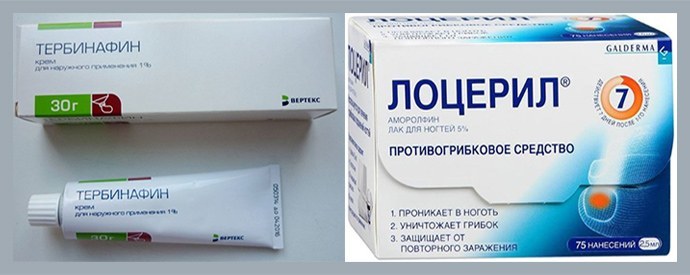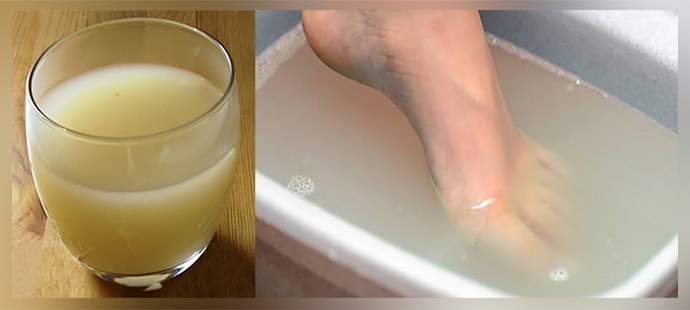Nail fungus in diabetes mellitus: treatment, course features
Content
- Conditions of nails and diabetes mellitus
- Darkening of nails with diabetes
- What is the reason for the lesion of the legs in diabetes?
- Why is the fungus dangerous in diabetes mellitus?
- Ingrowth of the plate into soft tissue in diabetes mellitus
- How to slow down the destruction of nails by fungus?
- How to treat fungus in diabetics?
- Medicines approved for diabetes
- Is there a difference in the treatment of nail fungus in type 1 and type 2 diabetes?
- Diet for diabetes and nail fungus
- Necessary preventive measures
A change in the condition of the nails for the worse is a common problem in diabetes mellitus. They are the first to suffer with such a diagnosis.
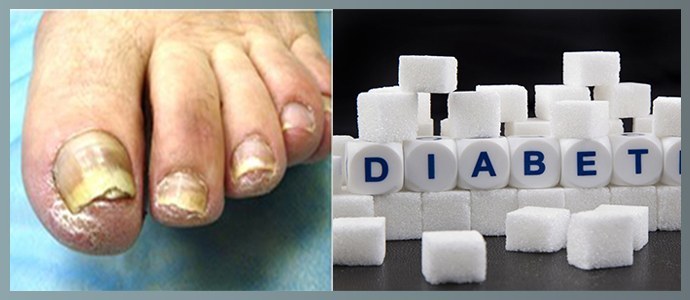
Treatment of this pathology should be carried out under the supervision of a physician without fail. This is due to the fact that nail fungus in diabetes can cause dangerous complications, including diabetic foot, which often ends in amputation of the legs.
Conditions of nails and diabetes mellitus
Quite often, persons with such a diagnosis complain of a deterioration in the appearance of the nail plates. Why is their condition changing? The fact is that any type of diabetes mellitus leads to the destruction of the capillary network that supplies blood to individual tissues of the body. This is due to the unstable presence of glucose in the blood.
As a result of a violation of trophism or nutrition, the matrix of the nail plate experiences chronic hypoxia and a deficiency of trace elements necessary for full metabolism. This circumstance becomes the cause of various structural changes in the nail and a decrease in local immune protection, which is a decisive factor in the accession of infection - fungal or bacterial lesions of the fingers and toes.
As for the lower extremities, the situation is aggravated by additional stagnation of venous blood, since almost all people with diabetes are diagnosed with varicose veins. To prevent the development of the pathological process, it is important to regularly examine the legs and pay attention to any, even minor, changes in the nail plates. With the timely identification of the problem, onychomycosis can not only be stopped, but also successfully cured.
Darkening of nails with diabetes
It was noted above that the vascular walls in diabetics are too fragile, therefore, various hemorrhages are not excluded, for example, against the background of trauma or excessive pressure on the feet. This rarely happens with healthy people, but in people with this disease, the situation becomes familiar, because in addition to the destruction of small capillaries, nerve endings are also subject to changes due to the lack of a full trophism. All this leads to the fact that patients feel their legs worse, often traumatizing them.

If there is a problem with a darkened nail roll, it is important to see a specialist as soon as possible. In the absence of adequate help, blood will continue to flow under the nail due to the impaired integrity of the vessels, and it is highly likely that an infection will penetrate there and the situation will be complicated by suppuration.
What is the reason for the lesion of the legs in diabetes?
According to statistics, every third person suffering from this disease is diagnosed with a nail fungus. Consider the provoking factors of onychomycosis in the following table.
| Causes | Description |
|---|---|
| REDUCED IMMUNITY | The body cannot resist the causative agents of fungal infection due to the weakness of the defenses. |
| INCREASED PROOF | Together with the separation of the secretion of the sweat glands, a small amount is thrown onto the surface of the nails and skin sugar, which leads to the formation of a favorable breeding ground for the growth and reproduction of pathogens microorganisms. |
| REDUCED SENSITIVITY | Deterioration of the innervation of the lower extremities leads to the fact that a person begins to injure his nails more often, sometimes without noticing it. In such a situation, the risk of attaching a bacterial or fungal infection increases significantly. |
| DISORDER OF BLOOD CIRCULATION IN THE LEGS | It is difficult for the body to deal with mycosis of the skin and nails even at the very beginning of its development, since the deterioration of the local trophism of tissues interferes with this. |
Why is the fungus dangerous in diabetes mellitus?
After the causative agents of onychomycosis get on microcracks, abrasions, cuts or an area of hemorrhage under the nail, and the immune system is unable to give a worthy specific response, the disease begins its development. And the key role here is played by increased sugar, which is the optimal breeding ground for microbes.
The fungus is actively multiplying, capturing new areas. The surface of the skin, especially in the interdigital zone, turns red, cracks appear on it, symptoms of itching and burning develop. The nail begins to deform, rising in waves over its bed, changing its color and structure. In the absence of therapeutic measures, the plate crumbles, exfoliates and can be completely torn away from the nail matrix.
The fungus spreads from the affected areas of the nail to the healthy tissue that surrounds it. The lack of medication leads to the fact that, in addition to damage to the plates - the main foci of onychomycosis, there are ulcerative changes, damage to blood vessels, bone and articular tissues, and skin. Subsequently, these signs become the cause of such a formidable complication as a diabetic foot. It is because of her that the patient's legs are amputated with this diagnosis.
Ingrowth of the plate into soft tissue in diabetes mellitus
Various nail problems are associated with poor circulation in the bed matrix. In addition to infectious pathologies, persons with diabetes mellitus often suffer from an ingrown toenail - with this diagnosis, the plate thickens and begins to literally cut into the surrounding tissue.
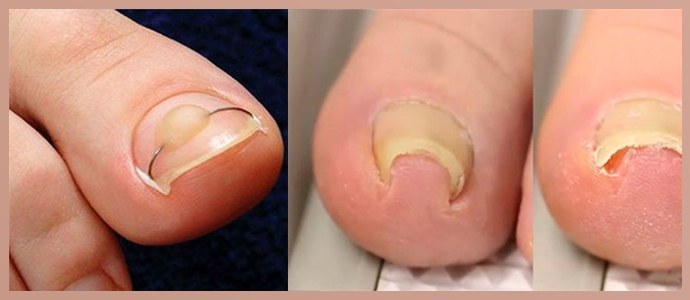
At the beginning of the disease, a person often misses this state, not attaching importance to it, again due to the disturbed innervation of the lower extremities. Gradually, the pathological process intensifies, inflammation and suppuration join the ingrowth of the plate, which, in the absence of therapeutic help, easily turns into a diabetic ulcer.
To prevent these events, it is important to monitor the condition of the nails, trim them in a timely manner, given that the corners of the plate should remain on top of the stock, they should never be rounded recommended. If you do this on purpose, sooner or later the nail will begin to "go" under the skin and even a healthy person will face its ingrowth.
If the problem already exists, then medical correction of the shape of the nail plate within the walls of a medical institution is necessary, up to resection (removal) of it surgically.
How to slow down the destruction of nails by fungus?
Onychomycosis can only be stopped by timely treatment. It is complicated by the fact that it is quite problematic for people with diabetes to choose antimycotic drugs, despite their range on the shelves of pharmacies. In any case, it is important not to self-medicate with detected onychomycosis, but to immediately contact a dermatologist at the first sign of trouble.
In no case is it recommended to resort to the dubious services of traditional healers, the advice of friends and other untested means. Onychomycosis in diabetics develops rapidly, and if you spend precious time on ineffective methods, you can face severe complications of the disease.
How to treat fungus in diabetics?
Therapy of mycosis of nails against the background of diabetes mellitus is seriously different from the classical treatment of healthy people. If the latter, having noticed the onset of the disease, have a good chance of getting rid of the defeat, simply having turned to the pharmacy and bought local antimycotics, then for diabetics such an alignment of events is practically unreal.
Each patient requires an individual approach to solving the problem. Treatment is planned in accordance with the results of laboratory tests and the patient's health status. The choice of antifungal agents for diabetes mellitus is seriously narrowing - few medicines are allowed for people with endocrine disorders.
At the same time, the doctor makes sure that fungicidal therapy does not worsen the effect of vital drugs - drugs that lower blood glucose, metabolism correctors, ACE inhibitors, etc. Antimycotics must meet the requirements listed below:
- Do not interact negatively with diabetes medications
- not cause hypoglycemia, that is, affect blood sugar levels;
- do not provoke side effects.
I would like to note right away that folk remedies for this disease are considered with a great deal of skepticism. If, for example, soda and iodine to some extent can affect the development of onychomycosis in a healthy person, then such experiments are not practiced in a patient with diabetes.
Medicines approved for diabetes
Treatment of nail fungus in diabetes mellitus is carried out necessarily taking into account the amount of glucose in the blood - its indicators should be reduced to optimal values.
Permitted drugs to combat onychomycosis are medicines based on fluconazole - Flucostat and Diflucan, or griseofulvin - Griseofulvin Forte. The dosage of the drug is selected by the doctor on an individual basis. Treatment for diabetes mellitus is usually designed for a long period of time - at least one year. To prevent relapses of the pathological process, the listed medicines can be prescribed prophylactically - once a month during the time required for the growth of a healthy nail plates.
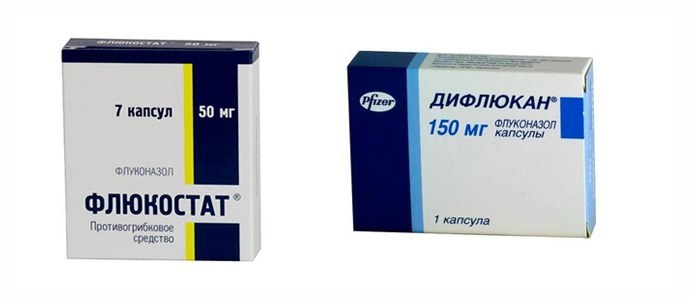
Among local antimycotics, people with diabetes are shown the use of such drugs Clotrimazole, Candide, etc.
Is there a difference in the treatment of nail fungus in type 1 and type 2 diabetes?
There are no fundamental differences. As well as there are no general recommendations for the appointment of certain drugs. It all depends on the stage of the lesion, the causative agent of the pathological process, the general condition of the patient and whether he has contraindications to a particular drug.
Diet for diabetes and nail fungus
The main rule of any diet is balance and nutrition. It is important to limit the amount of "harmful" products, replacing them with useful ones to the maximum, which will make up for the deficiency of vitamins and microelements in the body. When onychomycosis is detected, the diet will have to be slightly changed in order for the nutrition to help the defenses to cope with the attack of the fungal microflora.
The basis of the diet should include:
- natural yoghurts;
- cottage cheese, yogurt, fermented baked milk;
- eggs of chickens and quails;
- apples, lemons and other sour berries and fruits;
- yeast-free bread, sugar-free crackers;
- seaweed;
- fish, lean meat;
- vegetables.

Consider what dietary meals can be prepared from the listed products:
- Cod cutlets. 0.5 kg fish fillet, 1 egg, 1 carrot, 1 onion and a bunch of parsley. Grind all ingredients in a meat grinder, salt and form the meatballs. Bake in the oven without adding oil.
- Vitamin fresh. Mix 150 ml of carrot juice, 50 ml of beetroot and cucumber juice in a blender and use as a dessert. The product strengthens the body's defense system.
There are many recipes, and during their preparation it is important to remember that diet is a valuable part of the treatment of onychomycosis and candidiasis in diabetes mellitus.
Necessary preventive measures
To prevent infection with nail fungus, the following guidelines should be followed:
- Monitor your blood sugar regularly and take appropriate medications to keep it normal.
- Walk often in the fresh air and wear comfortable shoes that do not restrict the foot and do not interfere with normal microcirculation.
- Prevent hyperhidrosis - increased sweating of the legs.
- Wash feet daily with soap and wipe dry.
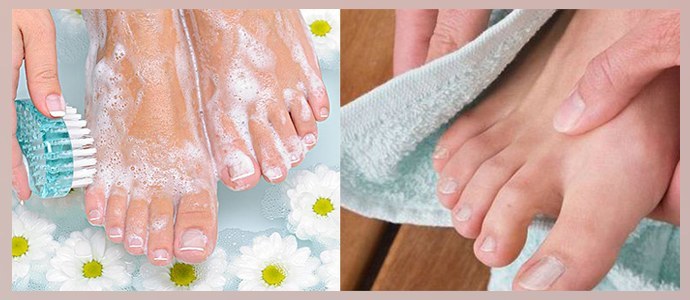
- If the skin is dehydrated, you can additionally treat it with a moisturizer to prevent cracks and injuries.
- Avoid overheating of the lower extremities.
Also, as a preventive measure, it is important to learn how to properly trim your nails. The corners of the plates cannot be removed with scissors; they must be carefully processed with a nail file. Public places such as saunas and baths should be avoided where the risk of onychomycosis infection increases.
Problems with nails are well known to persons with diabetes mellitus. Sometimes prevention is not enough, so at the first signs of a fungal infection, you do not need to hesitate to see a doctor.

